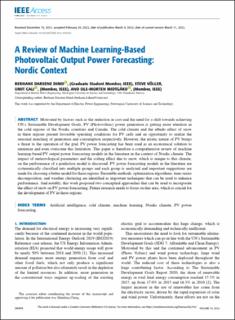| dc.contributor.author | Dimd, Berhane Darsene | |
| dc.contributor.author | Völler, Steve | |
| dc.contributor.author | Cali, Umit | |
| dc.contributor.author | Midtgård, Ole-Morten | |
| dc.date.accessioned | 2023-02-06T16:30:02Z | |
| dc.date.available | 2023-02-06T16:30:02Z | |
| dc.date.created | 2022-04-13T14:19:15Z | |
| dc.date.issued | 2022 | |
| dc.identifier.citation | IEEE Access. 2022, 10 26404-26425. | en_US |
| dc.identifier.issn | 2169-3536 | |
| dc.identifier.uri | https://hdl.handle.net/11250/3048705 | |
| dc.description.abstract | Motivated by factors such as the reduction in cost and the need for a shift towards achieving UN’s Sustainable Development Goals, PV (Photovoltaic) power generation is getting more attention in the cold regions of the Nordic countries and Canada. The cold climate and the albedo effect of snow in these regions present favorable operating conditions for PV cells and an opportunity to realize the seasonal matching of generation and consumption respectively. However, the erratic nature of PV brings a threat to the operation of the grid. PV power forecasting has been used as an economical solution to minimize and even overcome this limitation. This paper is therefore a comprehensive review of machine learning-based PV output power forecasting models in the literature in the context of Nordic climate. The impact of meteorological parameters and the soiling effect due to snow, which is unique to this climate, on the performance of a prediction model is discussed. PV power forecasting models in the literature are systematically classified into multiple groups and each group is analyzed and important suggestions are made for choosing a better model for these regions. Ensemble methods, optimization algorithms, time-series decomposition, and weather clustering are identified as important techniques that can be used to enhance performance. And notably, this work proposed two conceptual approaches that can be used to incorporate the effect of snow on PV power forecasting. Future research needs to focus on this area, which is crucial for the development of PV in these regions. | en_US |
| dc.language.iso | eng | en_US |
| dc.publisher | IEEE | en_US |
| dc.rights | Navngivelse 4.0 Internasjonal | * |
| dc.rights.uri | http://creativecommons.org/licenses/by/4.0/deed.no | * |
| dc.title | A Review of Machine Learning-Based Photovoltaic Output Power Forecasting: Nordic Context | en_US |
| dc.title.alternative | A Review of Machine Learning-Based Photovoltaic Output Power Forecasting: Nordic Context | en_US |
| dc.type | Peer reviewed | en_US |
| dc.type | Journal article | en_US |
| dc.description.version | publishedVersion | en_US |
| dc.source.pagenumber | 26404-26425 | en_US |
| dc.source.volume | 10 | en_US |
| dc.source.journal | IEEE Access | en_US |
| dc.identifier.doi | 10.1109/ACCESS.2022.3156942 | |
| dc.identifier.cristin | 2017209 | |
| cristin.ispublished | true | |
| cristin.fulltext | original | |
| cristin.qualitycode | 1 | |

